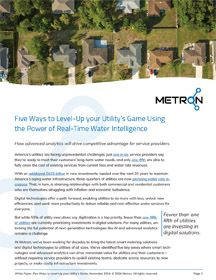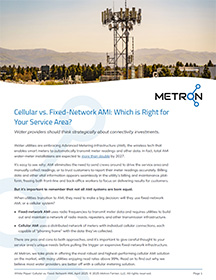
Advanced Metering Infrastructure
Driving the Future of Water Utility Management
Advanced Metering Infrastructure (AMI) is a powerful technology that changes the way water utilities manage resources, monitor consumption, and serve customers. AMI water systems incorporate smart meters, communication networks, and data management platforms to enable up-to-date, remote monitoring of water usage. Providing utilities with frequent, granular data on water consumption and system performance, advanced metering infrastructure improves efficiency, reduces costs, and enhances customer satisfaction. Moreover, AMI has a significant benefit on sustainable water management practices.
Get in touch to learn more about our metering infrastructure.
The Key Components of Advanced Metering Infrastructure
AMI consists of three core components:

Smart Water Meters:
These meters use electronic registers instead of traditional mechanical registers, which need to be read manually. Our electronic registers are capable of measuring water usage at one-minute intervals and periodically uploading those measurements to the network.
Communication Networks:
AMI relies on secure communication networks that transmit data between smart meters and the utility’s accounts on a central data management system. These networks can be wireless (e.g., cellular, radio frequency, or Wi-Fi) or use existing infrastructure. Metron’s meters communicate over existing cell-phone networks, such as Verizon.
Data Management Systems:
The data management platform processes and analyzes massive volumes of data collected by smart meters. This system enables utilities to identify trends in water usage, detect leaks, generate bills, and perform other analytics to help optimize operations and improve customer service.
What are the benefits of Advanced Metering Infrastructure for water utilities?
1. Enhanced Operational Efficiency
AMI systems eliminate the need for manual meter readings, which can be costly and time-consuming. With smart meters, utilities can remotely collect and access data from thousands of meters without sending personnel to each location. This improves operational efficiency, reduces labor costs, and minimizes human error. Furthermore, because water meters can be read daily (i.e. much more frequently than the monthly billing cycle), utilities can identify usage violations, as well as provide customers with more informed support, which builds trust and helps prevent disputes.
2. Leak Detection and Reduction
One of the most significant advantages of AMI for water utilities is early leak detection. Traditional meters do not provide real-time data, so small leaks or system failures may go unnoticed for weeks or even months, leading to significant water loss. With AMI, water utilities can monitor highly detailed consumption patterns frequently. Unusual usage patterns, such as a spike in water usage or constant low-level flow, can signal a leak or pipe failure. By identifying these issues promptly, utilities can respond more quickly, repair leaks before they waste large amounts of water, and avoid costly infrastructure repairs, and alert residents to leaks within their properties.
3. Improved Water Conservation and Demand Management
AMI enables utilities to track water usage with greater precision, providing insight into usage patterns. With this data, utilities can implement targeted conservation programs, encouraging customers to reduce consumption during peak demand periods or to adopt more efficient water-saving practices. AMI also allows utilities to offer dynamic pricing models, such as tiered pricing or time-of-use rates, which encourage customers to use water more judiciously during times of high demand or drought conditions.
4. Faster Response Times and Better Customer Service
Because advanced metering infrastructure systems provide near real-time data on water consumption, utilities can quickly identify issues such as service interruptions or billing discrepancies. When customers inquire about their usage or report problems, utilities can offer more accurate information and resolve issues faster. AMI also often allows customers to monitor their own water usage through online portals or mobile apps, giving customers greater control over their consumption and billing. This transparency enhances customer satisfaction and fosters trust between utilities and their customers.
5. Data-Driven Decision Making
AMI provides water utilities with a wealth of data for long-term planning and system optimization. By analyzing trends in water consumption and identifying inefficiencies or problem areas in the system, utilities can make data-driven decisions to repair or improve infrastructure, optimize water distribution, and reduce operational costs. For example, AMI can help utilities identify underperforming zones or sections of the distribution network that may need replacement, as well as predict future water demand more accurately, allowing for better resource planning.
6. Support for Sustainable Water Management
As the global demand for water increases and the impacts of climate change make water resources more unpredictable, sustainable water management is a greater priority for utilities. AMI promotes sustainability by helping to reduce water waste, improve resource allocation, and detect inefficiencies in the system. By enabling more precise monitoring of water use, AMI contributes to better management of limited water supplies, especially in drought-prone regions, and helps utilities adapt to changing environmental conditions.

Metron streamlines water metering.
Advanced metering infrastructure represents a transformative step forward in how water utilities manage resources, deliver services, and engage with customers. By providing near real-time data on water usage, enabling quick detection of leaks, and enhancing operational efficiency, AMI helps utilities reduce waste, lower costs, and improve service delivery. Moreover, customers have more visibility into their water usage. As water scarcity continues to be a growing concern globally, AMI will be essential in helping utilities build smarter, more resilient water systems to meet the demands of the future.
Get in touch to learn how our metering infrastructure can help you.
AMI has been making waves in the water management industry by offering utilities *almost* real-time visibility into their water distribution data. This affords many operational efficiencies such as fewer trucks and truck rolls, quicker leak detection, and more informed financial planning. If your utility is still only relying on monthly meter reading, you are likely missing out on a lot of helpful data that can drive better operational decisions.
First off: It is never a simple project to implement AMI. Integration with the billing, GIS, and customer service platforms can get complex, and another set of specific challenges can arise in rural and/or low-density geographies as well. Thankfully, Metron has decades of experience running complicated AMI projects with a lot of moving parts. But rest assured, once your new AMI system is in place, the long-term operational gains definitely outshine the friction it takes to get started.
Many cellular AMI systems are grabbing water usage data and pushing it to the cloud every 15 minutes (sometimes the frequency is even higher). A refined advanced metering infrastructure system will include a data management platform that analyzes the usage data and creates helpful insights. Utilities and other Metron customers use the AMI data to become more proactive about detecting leaks, along with improving demand forecasting, creating a predictive maintenance process, and much more. There are a lot of ways to put the data to work!
There’s no such thing as a silver bullet when it comes to AMI. Things like cellular signal interference and integration with older, legacy infrastructure can offer many opportunities for frustration. Not all residents love the idea of their water usage being monitored more closely, too (so sometimes the change to AMI can cause a lot of customer calls and questions – requiring a bit more operational support). For MOST utilities and multi-family properties, the benefits easily outweigh the downsides.
Advanced Metering Infrastructure Resources
Are you in the middle of your research? We’d love to help.
Metron has decades of experience helping customers integrate advanced metering infrastructure into their utilities. Be sure to check out our case studies vault, along with taking some time to peruse our white papers. If you’d like to set up a quick chat with one of our water management experts, feel free to contact us any time. Our team is ready to help you find the best solution possible, and we’re happy to answer any questions you have.
Don’t fall behind—the upside of advanced metering infrastructure is too good to ignore. If your utility is still relying on manual monthly meter reads and outdated formulas for billing, it could be time for you to integrate AMI and experience the benefits firsthand.
 White paper
White paper Check out our new white paper!
Check out our new white paper!